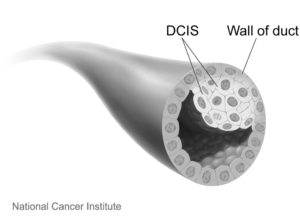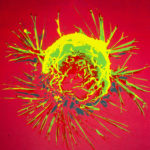How Bandersnatch Mirrors a Cancer Journey
A few minutes into watching the compelling new Black Mirror episode Bandersnatch, in which the viewer chooses the story path, I realized that the experience echoes a journey with breast cancer.
Black Mirror, the brainchild of Charlie Brooker, debuted in the UK in 2011 and migrated to Netflix in 2016. The series imagines the negative effects of technology with stunning prescience, each episode a peek at a different world, with just enough familiarity to unleash a wave of unease. Wrote Mr. Brooker in the new book “Inside Black Mirror,” “I’ve already repeatedly experienced what it’s like when Black Mirror stories slowly manifest themselves in the real world. Not sure that’s going to be much comfort when I’m being chased across an irradiated landscape by an autonomous robot bum-on-legs with the Facebook logo etched on its perineum and a Make America Great Again hat perched on top, but you can’t have everything.”
Black Mirror Takes the Twilight Zone to a Brave New Level
I’ve been hooked since the first episode, which was so disturbing some people never tuned in again. I’ve watched the award-winning San Junipero episode many times, always seeing more. It is genius.
This year, the special Bandersnatch episode debuted at the same time as the annual New Year’s marathon of the Twilight Zone, the inspiration for the series. Beth Elderkin summarized the plot in Gizmodo:

“Black Mirror: Bandersnatch is an interactive one-off special about a young man named Stefan who’s turning his favorite Choose Your Own Adventure-style fantasy novel into a video game. Much like Alice in Alice in Wonderland (where the name Bandersnatch originated), Stefan falls deeper and deeper down the rabbit hole, to the point where he starts to question his ability to control his own destiny. Which, as we well know, he can’t.” (Actually the name comes from The Jabberwocky poem in Through the Looking Glass.)
Elderkin means “rabbit hole” literally. The hazy memory that haunts protagonist Stefan is the day, when he was 5, when a search under his bed for his stuffed rabbit delayed his mother catching a train – and the later one that she took derailed. The Bandersnatch game he’s inventing circles back to that key incident, like a hybrid of Groundhog Day and Memento, tiny key changes unfolding at each iteration. The parallel paths, dead ends, loops within loops and twists and turns of Bandersnatch can keep the participant glued to a device for hours.
Every few minutes, a narrow white band at the bottom of the screen offers a choice, which drives the narrative.
It’s the mid 1980s. The decisions that Stefan faces as we meet him as a 19-year-old are initially innocuous – breakfast cereal (Frosties or Sugar Puffs) and song choice from cassette tapes (Hold Me Now or Here Comes the Rain Again). But the choices quickly ramp up to accept/refuse a job offer, whether Stefan or fellow gamer Colin leaps from a high balcony, whether a murder victim is buried or chopped up, a computer smashed or drenched in tea … it goes on and on and on.
Soon after Bandersnatch dropped, detailed flow charts flooded the Internet, fans posting guides to manage the roads not taken. The diagrams resemble others: subways maps, fashion choices, medical treatment protocols, game plans, military strategies, the Krebs cycle, cell lineages, “interactomes” depicting gene expression pathways. The representations also recall the choreography of mutations that underlie the origin, gestation, and spread of a cancer.
Breast Cancer Journeys
I meandered through Bandersnatch four days ago with my best pal Wendy, she recovering from a lumpectomy, me from a second mastectomy. The metaphor to our situations built as Stefan unraveled his past and tried to guide his future.
The beginning of a breast cancer journey is linear as suspicion rises: routine mammogram, repeat mammogram, 3D mammogram, ultrasound, MRI, finally reaching the first diagnostic crossroads: no biopsy and exit the game, or biopsy and continue.
A biopsy shows:
- No growth, benign growth, malignant growth
- If malignant, location in breast
- Propensity of cells to divide (grade)
- A glimpse of the future, from 0 to 4 (stage)
- Inflammation? Necrosis? Invasion?
 A year ago I was diagnosed with ductal carcinoma in situ (DCIS). Cancer cells were piling up in a milk duct, on the verge of spilling out into an invasion.
A year ago I was diagnosed with ductal carcinoma in situ (DCIS). Cancer cells were piling up in a milk duct, on the verge of spilling out into an invasion.
A few days after the biopsy results are in, receptor status arrives. Cancer cells sporting receptors for estrogen, progesterone, and/or human epidermal growth factor mean the errant cells maintain some specialization. That’s good, because the cancer is less advanced, and several drugs can plug the receptors to block signals to divide. This is why “triple negative” breast cancer is particularly fierce. Hormone and growth factor blockers aren’t classic chemo that kills many types of dividing cells; they’re targeted.
More decisions.
Lumpectomy or mastectomy? Reconstruction or flat? New tissue synthetic or from another body part, like belly fat?
Meanwhile, samples from the surgery are sent for a test of tumor cell gene expression, which is used to predict response to certain drugs as well as recurrence risk. I wrote about the development of two such tests commonly used today, OncotypeDX and Mammaprint, in 2003 in The Scientist. So they’ve been around awhile.

Since that time, “gene expression profiling,” which is what the tests do, has rebranded itself into “genomic testing,” which isn’t quite correct. OncotypeDX looks at the expression of 21 genes, and Mammaprint at 70 – hardly the 20,000 or so genes in a human genome. This marketing approach may make some patients, and perhaps providers, think that the test is more extensive than it actually is. Converting those gene expression patterns into “oncoscores” is not at all the same as identifying the driver mutations behind cancer, either the inherited ones like the BRCAs that everyone fears, or the somatic ones that cause most cancers, popping up only in the affected cells. But gene expression correlations can save some patients from suffering through a treatment that likely won’t work.
Oncoscores in hand, we move forward.
If we follow the lumpectomy path, radiation and hormone blockers and/or chemo loom. To me, lumpectomy and the aftermath seemed like being stuck in Bandersnatch, unable to exit the nightmare, each choice leading to more options and even looping back to repeat the lumpectomy if margins aren’t clear of cancer cells. I also found a case report of a supposedly contained DCIS like I had showing up in a woman’s liver seven years later. That’s rare, but it happens, despite my oncologist cheerily proclaiming “DCIS isn’t even cancer” – here’s my answer to that!
Even with treatment, the earlier choices can loop in again – more scans, another biopsy or lumpectomy.
Our breast cancer journeys vary in many ways, with decisions based on many factors: age, family situation, relationships, genetic test results, insurance, finances, importance of appearance, profession, fear of recurrence.
I chose to be done with it, based on my family history, logical for someone obsessed with genetics. Although I have no inherited mutations (104 genes tested), the panels don’t test for them all, and 90-95% of cancers are due to mutations in the affected cells, not to inherited risk. A clear genetic test panel didn’t mean I was home free. I also considered what other women with breast cancer had done and how they had fared.
My mother did what her doctors told her, back during the time of Bandersnatch, pre-Internet and when many patients didn’t realize that treatments are choices. Mastectomy, hormone blocker, radiation, chemo after chemo after chemo until the end. She did it all. And her choice ultimately drove mine.
A good friend had a double mastectomy for cancer in one breast, and it was in the second one too. She had seven reconstruction surgeries until one day a nurse warned her to be on the lookout for her new nipples sliding off. She went flat.

Another friend’s sister developed breast cancer in her thirties, leading to genetic testing of sisters and cousins, and my friend discovered that she had inherited the family’s BRCA mutation. She had a double prophylactic mastectomy with complete reconstruction, the Angelina Jolie route.
Sometimes, again like Bandersnatch, events loop backward and unveil an alternative, happier ending. That happened to my friend Wendy.
She barreled along the first part of the journey: bad scans, biopsies, diagnosis (DCIS), consults at two major cancer centers. Then a few days after her recent lumpectomy, her physician called: pathology showed she didn’t have DCIS after all! Her choices going forward changed instantly. I was so happy for her, and thought of Led Zeppelin. “Yes, there are two paths you can go by, but in the long run, there’s still time to change the road you’re on.” I didn’t realize taking back a cancer diagnosis was a thing.
Cancer Cell Lineages
Just as Bandersnatch meanders along different pathways, so does cancer.
Each time a cancer cell divides, like each time that white stripe appears on the screen as Stefan faces another choice, the DNA in one or both of the resulting daughter cells can mutate. Interrogating the “mutational landscape” of a cancer is quite different from the older classification of breast cancers into just five groups based on location and receptor status.
Revealing the mutational landscape of a cancer is increasingly important for targeting treatments (see “Mutation and Location Important in Cancer Treatment,” which I wrote for Lancet Oncology in 2015 or the accessible version here at DNA Science.) A study from 2017 sequenced bits of tumor DNA from the bloodstreams of 100 women with advanced breast cancer and catalogued dozens of mutations (see “Can Liquid Biopsies Compete with Scopes and Scans in Cancer Diagnosis?”). Bottom line? The tumors differed in many ways. A treatment plan dictated by body part no longer makes much sense.

The similarity of cancer to a video game transcends breast cancer. A study published yesterday in Science Translational Medicine revealed one reason why women respond better to the standard drug used to treat the brain cancer glioblastoma and live longer than men: different patterns of gene expression. While the mutations driving a woman’s glioblastoma dampen expression of nine genes that promote cells receiving messages (signal transduction via integrin proteins), the drivers of male glioblastomas affect control of cell division rate. Different mechanisms call for different treatments.
The Optimal Ending?
The chronology of Bandersnatch is complex and fluid, a constantly changing response to choices that bend time, obliterating the linear. The many diagrams from fans mark the early exits, but most users navigate the loops, inching towards and converging at the most satisfying conclusion. I won’t spoil it.
Yet even when it comes to endings, the game mirrors cancer in that most players reach the preferred outcome. These days, thanks to our ballooning understanding of the mutations and gene expression patterns that underlie cancers, more travelers along the cancer journey are reaching the most satisfying conclusion, for longer and longer times: NED, for “no evidence of disease.”
I hope I’m there now.
IMAGES red in center cells slow cycling green is fast blue are nuclei


[…] How Bandersnatch Mirrors a Cancer Journey | DNA Science PLoS Blogs […]